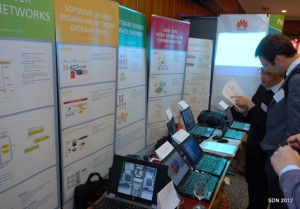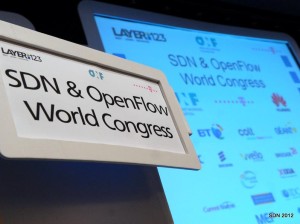…And we did it! Being a part of the biggest event in Software Defined Networking – the Second SDN and OpenFlow World Congress, was truly a challenging and inspirational experience. Over 700 delegates from all over the globe coming together to share their unique knowledge – a truly must-go event.
Just in case you’re wondering what on earth I am talking about, on October 15-18 Layer123 conducted one of the world’s most significant Networking events – SDN & OpenFlow World Congress. The event was held in Bad Homburg – a small town 15 kilometers to the north of Frankfurt. This silent and cozy place got crowded by SND World for four days, to the extent that it was hard to find a place for dinner where you would not hear SDN, NFV, OpenFlow, and other networking buzzwords. The town itself is very compact, with several nice churches and the “White Tower”.
Bad Homburg is noted for its mineral waters and casino, but my companion Mykhailo Fliorko, PLVision’s Director of Business Development, and I spent all the time in another sort of gamble – watching SDN roulette cycling and people putting bets on it. It seemed that everybody had their own winning scheme, and the winner will be known in a couple of years.
I came to the conference with one big question – What is SDN? Is it marketing hype, or a real thing? And the answer is – it’s both. It’s a real thing, because SDN feels quite comfortable in the core of datacenter/clouds with lots of solutions running in production. And it’s a hype to some extent, because in other areas of Networking it’s still at the stage of immaturity. Carriers are already experimenting with SDN, but speaking about enterprise world, SDN is still just approaching the door to knock at it.
Returning to the carrier equipment, no SDN-enabled optical switches were presented; most of the companies demonstrated MPLS-based carrier Ethernet solutions, although Huawei promised to have something within a year. Many of the vendors said that they were missing a common well-defined protocol in order to venture into this area. Speaking of which, it looks like OpenFlow version 1.5 may include carrier grade optical features. On the other hand, there are alternative solutions – Intune Networks offers a carrier grade optical solution which is wrapped in a regular L2 switch interface. The way I see it, this approach best matches inter-data-center transport.
Photo taken from: www.layer123.com

Some concerns were expressed about performance of carrier NFV deployment on commodity servers. The latter are challenged with high speed streams that are transmitted in the carrier networks. And this is where the chip manufacturers are coming up with network processors to speed things up. Some of them declared that they can process 10 times more traffic than Intel x86 accelerated with DPDK. Their network processors can run Linux, or any network application or utility on top of it (OVS for instance). This in turn enables existing programs written in C programming language with high-performance traffic processing.
On the whole, the congress felt like a dynamic kaleidoscope of people, technologies, and ideas. People were eager to communicate, and in three days I felt like I knew some of them for many years (Even started speaking to them in Ukrainian before I realized what was wrong about it ![]() ). To sum up, my strongest impression is that carriers are now missing equipment development power which was taken away from them, like in case of AT&T and Lucent. If we trace back the history of split-ups and acquisitions, we will see that it all started with “Mother Bell”, the common ancestor of most telecoms and equipment vendors. Events like World SDN and OpenFlow Congress are like Networking family reunions, where we all come to resolve problems and to move forward.
). To sum up, my strongest impression is that carriers are now missing equipment development power which was taken away from them, like in case of AT&T and Lucent. If we trace back the history of split-ups and acquisitions, we will see that it all started with “Mother Bell”, the common ancestor of most telecoms and equipment vendors. Events like World SDN and OpenFlow Congress are like Networking family reunions, where we all come to resolve problems and to move forward.
- 10 Reasons NOT to Deploy
SONiC NOS in Your Network - July 12, 2024 - Choosing the Right SONiC Version for Your Network Infrastructure - May 15, 2024
- SONiC-DASH: Integration for a DPU in 4 Steps - January 23, 2023




